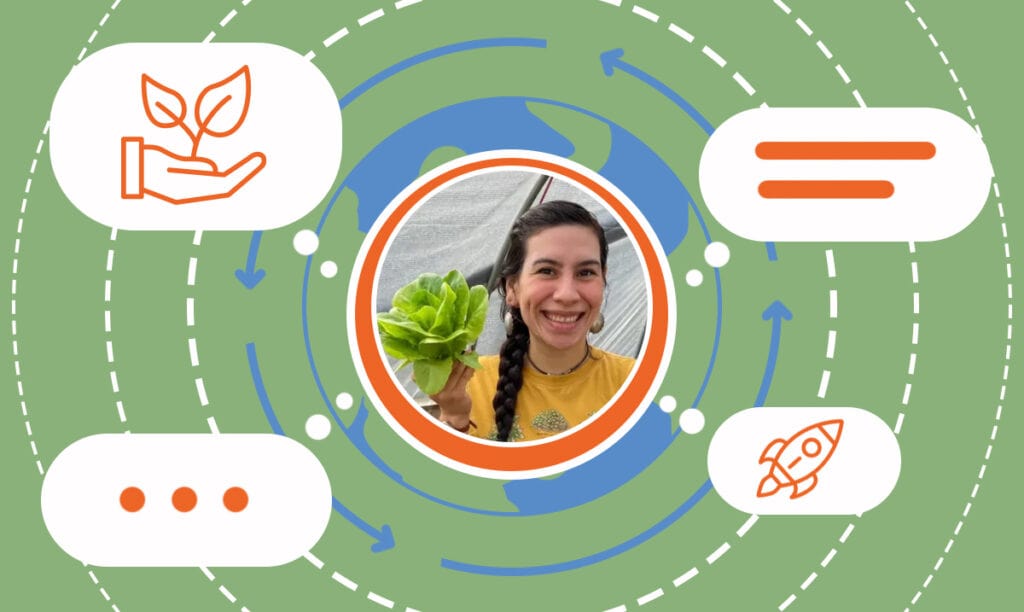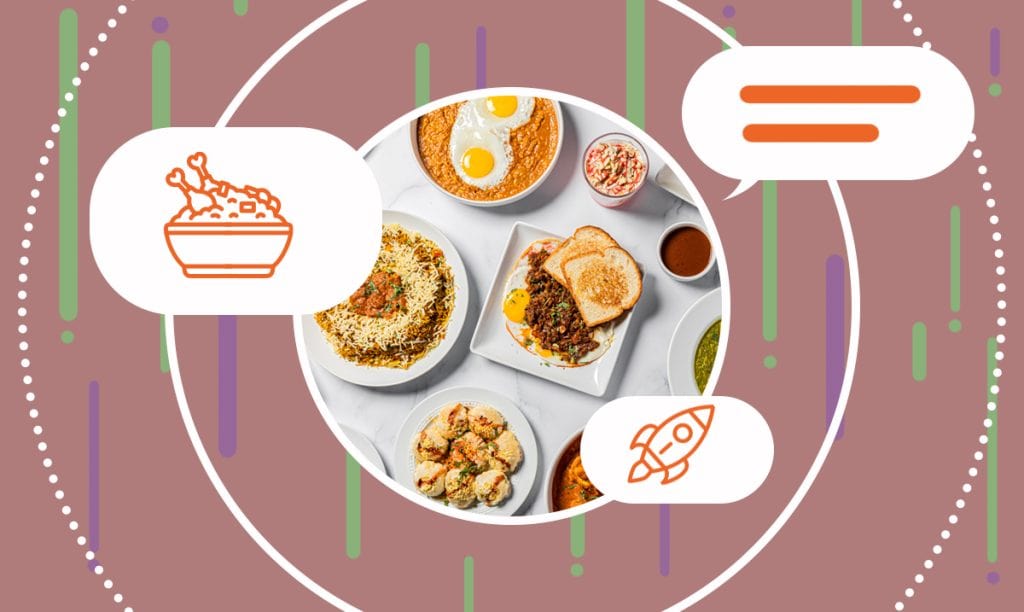In this interview, we sit down with Raimonds Selga, co-founder and board member of Kalve Coffee, a fast-growing specialty coffee brand based inLatvi ...
Marcella Juárez on Leading Sustainable, Organic Local Farming
Written by: Esther Strauss
Esther is a business strategist with over 20 years of experience as an entrepreneur, executive, educator, and management advisor.
Published on March 11, 2024

As the owner and farm manager of Palo Blanco Farm and Ranch in Laredo, Texas, Marcella Juárez has revitalized a family legacy spanning over 160 years into a modern, sustainable, and community-oriented enterprise.
In this interview, we delve into the heart of regenerative agriculture through Marcella’s eyes, exploring her journey from embracing ancestral farming roots to integrating cutting-edge techniques like solar power and hydroponic greenhouses.
Join us as we uncover the challenges, triumphs, and visions of a dynamic entrepreneur reshaping the landscape of sustainable farming. Marcella’s insights not only illuminate the path for aspiring farmers but also resonate with anyone passionate about eco-conscious living and local food movements.
Sustainability Practices
SBS – How do you implement and maintain sustainable farming practices in your day-to-day operations?
Marcella – Start small, be strategic, evaluate, and allow things to naturally evolve. We are a small, family-owned business that operates with a strategic approach. Our journey began with a very small-scale indoor production of microgreens, hydroponic sprouts, and farm-fresh eggs. As our customer base and our presence in the community expanded, so did our operations. We evolved and tripled our indoor production of microgreens and constructed a hydroponic greenhouse, enabling us to offer hydroponic herbs, lettuce, and edible flowers. Currently, we are in the process of converting a shipping container for year-round hydroponic production, our next evolution, so to speak. Our growth strategy involves incremental yet deliberate steps and allows for natural evolution.
Before planting our first seed, I devised a comprehensive business plan outlining the projected growth of our operation and customer base. The emphasis has always been on starting small and making smart and strategic choices. We prioritize starting small to avoid overstretching our budget on any single project. We’ve ensured efficient operations and production methods by making informed decisions and expanding strategically. For example, opting for hydroponic production has further streamlined our processes by reducing labor-intensive tasks such as weeding and field preparation. This efficiency has made the overall maintenance of our operation much easier and facilitated our capacity to scale up as the business grows. Since we began, we have made conscious efforts to make things more efficient — including ourselves — allowing for increasingly efficient day-to-day management.
We remain committed to our initial plan, with the ultimate goal of transitioning to regenerative field production. By following this plan and starting small and strategically, we anticipate that those choices will help us finance and reach our ultimate goal. With a well-crafted plan and a series of strategic steps, we aim to implement even more environmentally sustainable farming practices.
Challenges and Adaptations
SBS – What are the biggest challenges you’ve faced in your farming business, and how have you adapted to them?
Marcella – We’ve encountered numerous challenges in our operations, but perhaps the most significant is the South Texas climate. Each summer seems to grow progressively hotter, with last summer registering record-breaking temperatures, easily hitting 115°F. This necessitates a strategic approach to production in such a demanding environment.
Operating within the distinctive market of Laredo also presents its own set of hurdles. Certain areas in Laredo are classified as food deserts, characterized by limited access to fresh produce. Moreover, our community grapples with a poverty rate double the national average and a disproportionately high prevalence of diabetes. I have often heard that if I were operating in Austin, I wouldn’t face the same obstacles as a local farmer, such as pricing. However, I love my community, and we deserve access to fresh, local, and sustainably grown food. So, as a small-scale producer aiming to serve our community and sustain our livelihood, we face the complex challenge of balancing these dual objectives. Despite this, we are committed to providing our community access to fresh, local food.
As a small, local producer, we often encounter policy challenges. As we expanded, we had to navigate the ag policy. We have begun to advocate for the interests of small producers in an industry predominantly tailored to large, corporate, global entities. Addressing policy challenges that small producers face is yet another aspect of our mission to maintain local food systems and ensure equitable access to nourishing food for all. This also includes engaging in educational outreach. Educating our community further underscores our commitment as we strive to impart knowledge about our products, healthy eating practices, the broader food system, and the true value local and sustainable farmers bring to their communities.
Business Growth
SBS – How has Palo Blanco Farm and Ranch evolved since its inception, and what were the key factors in its growth?
Marcella – We’ve undergone a remarkable evolution since our humble beginnings. I can vividly recall those early days when we were just getting started, experimenting with using jars for packaging and constructing our website, microgreen shelves, and greenhouse from scratch. The concept of farm-to-table deliveries was merely an idea we discussed.
Since then, we’ve experienced multifaceted growth. Our customer base has expanded, as has our presence and impact within the community. As a farm, we’ve embarked on ambitious projects, such as repurposing a shipping container into a hydroponic farm, diversifying our offerings to include local beef alongside our existing products, and expanding our egg production.
Moreover, we’ve embraced advocacy, actively engaging in policy discussions that impact small producers like ourselves. This growth isn’t confined to our business; it extends to our familial and individual spheres, enriching our presence within the community. Such progress has been made possible through collaboration, rigorous evaluation of our strategies, and a willingness to adapt. We continuously experiment with and refine our approaches, guided by a commitment to problem-solving and a genuine passion for our work.
Cultivating strong community relationships is paramount, fueled by our unwavering dedication and enthusiasm for what we do. I’m driven by the belief that even with unlimited resources, I’d still choose to pursue this path. This intrinsic motivation fuels our growth and evolution, propelling us forward with unwavering dedication and purpose.
Customer Engagement
SBS – How do you engage with your customers and community to promote your farm-to-table products?
Marcella – Customer engagement has played a pivotal role in propelling our growth forward, especially since we started in 2020. We’ve fostered meaningful connections through active participation in the local farmers market, consistent online presence, and community involvement. Our communication channels, including email newsletters and social media platforms, serve as conduits for sharing insights into sustainable farming practices and offering glimpses behind the scenes of our ranch operations. These efforts have enhanced awareness and facilitated the cultivation of strong relationships with our valued customers.
We try to add a personal touch to all that we do. From something as simple as writing your name on your order to sending you personal texts and reminders for upcoming deliveries to delivering directly to customers’ homes and feeding their families, we build personal connections and emphasize the special relationship between a customer and their local farmers.
Technology in Farming
SBS – How have technologies like solar power and hydroponics impacted the efficiency and productivity of your farm?
Marcella – Technology has revolutionized our production capabilities here at the ranch and made production possible.
Installing solar panels has been indispensable, providing us with a reliable power source and serving as a crucial safety net for our farm and ranch operations, particularly in light of the frequent power outages we experienced living on the ranch. With solar power and battery backup, we’re assured that our crops won’t be jeopardized during unexpected outages, safeguarding our investment of time, effort, and resources.
Moreover, integrating hydroponic systems has enabled us to surmount numerous challenges prevalent in South Texas, such as extreme heat and water scarcity. Hydroponics utilizes 90% less water and occupies significantly less space than traditional farming methods, accelerating our productivity while conserving resources. This has propelled us years ahead in terms of production compared to traditional field methods while facilitating our expansion into more regenerative field practices.
Additionally, we implemented a state-of-the-art water filtration system. We were previously reliant on mineral-rich well water that was not suitable for plant growth. Our ancestors used to practice dryland farming, which meant there was no irrigation and you relied on rainfall. This advanced water filtration system ensured not only potable drinking water for our household but also suitable water for plant cultivation, making production possible. With access to clean, filtered water, we’ve overcome the largest obstacle, making hydroponic production and overall farm operations feasible and sustainable in our challenging environment.
In summary, these technological advancements — solar power, hydroponics, and water filtration — have been indispensable in overcoming the unique barriers we face in South Texas. They have not only enhanced our productivity and sustainability but have also empowered us as young farmers to thrive in our local agricultural landscape.
Regenerative Farming Techniques
SBS – Can you elaborate on the benefits and challenges of using regenerative farming methods like Hugelkultur raised beds?
Marcella – Traditional field production posed significant challenges due to intense heat, drought, and competition from various critters; our plants often didn’t survive beyond a day. Transitioning to raised Hugelkultur beds proved to be a solution, effectively mitigating these issues while significantly reducing the labor-intensive tasks of weeding and garden maintenance. This marked our initial, small-scale attempt to implement permaculture practices and set the stage for our transition towards more regenerative field practices — a journey to which we’re fully committed.
Our immediate focus is financing essential equipment, fencing, water troughs, and watering systems to facilitate our transition to regenerative grazing practices. Our Hugelkultur raised beds lay the groundwork for subsequent endeavors in regenerative production. However, transitioning to regenerative farming poses its own set of challenges, notably the need for both financial support and technical assistance.
As a young farmer, the responsibility of being a farmer, accountant, website designer, etc., often falls on my shoulders, so seeking expert guidance on maximizing the land’s potential for regenerative practices is essential for successful implementation versus going about it on my own. Limited budgets and manpower underscore the importance of strategic planning and expert guidance in implementing these practices effectively. Despite these obstacles, our commitment to regenerative agriculture remains unwavering. I am deeply passionate about regenerative farming and am eager to overcome these challenges as we work towards realizing our vision.
Market Trends and Response
SBS – How do you keep up with market trends and consumer preferences in the farming and food industry?
Marcella – Currently, our focus is on producing high-quality, wholesome local food. It’s evident that many customers and consumers are gravitating towards this preference, seeking out the type of food we’re passionate about providing. While we’re not necessarily following trends, we’re keenly attuned to the desires of our customers, recognizing their hunger for quality products.
Also, being a part of the community that we are serving, we understand the importance of offering culturally significant foods or new foods in a culturally significant way that makes them more palatable, familiar, and desirable. In our Laredo market, we aim to underscore the significance of supporting small, local, and sustainable farmers, thereby cultivating a more localized market.
The overwhelmingly positive response and support from our community further reinforce our commitment to prioritizing their needs. Our community-centric approach guides every decision we make, ensuring that we continually strive to deliver the finest quality food that resonates with our community’s preferences and values.
Educational Outreach
SBS – Do you have any educational programs or outreach initiatives to educate the community about sustainable farming?
Marcella – Expanding our reach to encompass educational programs and community outreach initiatives is a priority for us. Our goal is to foster engagement within the community by offering hands-on workshops and educational sessions that shed light on the importance of sustainable farming and the dynamics of our food system.
We envision creating spaces where meaningful conversations can thrive, potentially hosting screenings of food documentaries to kickstart dialogues within our community. While this remains a work in progress, we are committed to bringing these initiatives to fruition in Laredo and promoting a more sustainable food culture.
Risk Management
SBS – What strategies do you use to manage risks and uncertainties in farming, such as weather fluctuations or market changes?
Marcella – Risk management is an integral aspect of the strategic decisions we’ve made for our operations. Utilizing indoor production powered by solar panels not only safeguards against potential crop losses during extreme weather and power outages but also ensures the continuous functioning of our water pumps, thereby mitigating risks effectively.
Our strategic approach extends beyond crop selection to include production methods, enabling us to navigate challenges that traditional farmers may find more daunting. Despite facing recurring challenges such as record-breaking heatwaves, droughts, and freezes in South Texas, our commitment to sustainable practices and solar-powered solutions provides invaluable support in caring for our plants and animals and making our operation more resilient.
Starting our farm and ranch business in 2020 amid the uncertainty of the pandemic and operating through record-high inflation presented significant challenges. However, we successfully weathered this storm during our initial growth phase, adapting to the prevailing circumstances. Since then, we’ve witnessed a robust and expanding market base driven by consumer demand for higher-quality food — precisely what we’re proud to deliver. This alignment between consumer preferences and our product offerings serves as a buffer against various risks in market changes, ensuring our continued resilience and success in the face of uncertainty.
Product Development
SBS – How do you decide to introduce new products, and what is the process behind developing them?
Marcella – We first decided on what products to introduce based on our limited capacity. Microgreens, sprouts, and farm-fresh eggs were easy to produce and required very little resources and infrastructure. We took the time to introduce these new foods to our community in a culturally relevant way and educate them on the nutritional benefits and how to use these products in their day-to-day lives.
Now, we often receive requests from customers to grow new varieties of microgreens and wheatgrass and/or introduce other products. When we consider introducing new offerings, it’s typically driven by either customer interest or our own enthusiasm for the product. Initially, our decision-making process was guided by what we, as consumers ourselves, desired, alongside customer feedback. We began by experimenting with new varieties and products and sampling them at the farmers’ market to gauge interest and demand.
Understanding our community and customer base is crucial in determining what products to offer. This knowledge has played a significant role in guiding our decisions and shaping our product lineup. We also defer back to my initial ranch plan, which included plans to scale and offer new products as we grow, such as local beef, which is a staple for families and much higher quality than what is typically offered in grocery stores. Feeding our community is truly at the heart of our operation, and providing fresh, local, and healthy staples, such as eggs and beef, truly is our destination.
Environmental Impact
SBS – What measures do you take to ensure your farming practices have a minimal environmental impact
Marcella – Growing up on the ranch that has been in our family for over 160 years instilled in us a deep love and respect for the land. When I decided to become a farmer here, I was determined to adopt practices that would not only preserve but also enhance the health of the ranch. I aimed to improve soil health and cultivate drought resilience, viewing these objectives as essential from the outset, even when it was merely a dream in my 18-year-old mind. This commitment has guided my journey ever since, shaping my ongoing pursuit of knowledge and education. I actively seek out opportunities to expand my understanding through webinars, conferences, and other resources, always on the lookout for innovative practices that promote environmental sustainability and land stewardship.
I’m proud to have pursued this passion academically, obtaining a master’s degree alongside my brother in agriculture, with a focus on hydroponics and sustainable production. For over a decade, sustainable agriculture has been the central focus of my life, driving my dedication to responsible land management. Our connection to the land runs deep, and we continually strive to discern between practices that may harm or benefit it, ensuring that our stewardship remains rooted in respect and preservation.
Advice for New Farmers
SBS – What advice would you give someone starting a farm or agricultural business today?
Marcella – For aspiring farmers, my advice is to thoroughly understand your market. Identify any gaps or opportunities you can fill by observing what’s available and what’s missing. Begin with a small-scale, strategic approach supported by a solid ranch or business plan outlining your growth trajectory.
Consistency is key: show up in your community, at farmers’ markets, and online, as a strong online presence can significantly bolster your visibility. Building genuine relationships with your customers is paramount for expanding your customer base; prioritize delivering high-quality products.
Continuously educate yourself through webinars, conferences, and workshops, seek guidance from experienced farmers, and remain open to learning from others. Learn about the practices you are trying to employ and learn more about our food system. As a farmer, you need to educate not only yourself but also your customer base for long-term success. Every farm is unique, so understanding your location, community, and personal capacities is essential. Adaptability is crucial, especially when facing location-specific challenges, whether you’re farming in an urban setting, in your backyard, on a couple of acres, or on family-owned land like ours. Remember, farming is a marathon, not a sprint, so practice self-compassion and patience. Despite its challenges, farming is an immensely rewarding journey, and I wish you all the best in your endeavors.
Future Plans
SBS – What are your future plans for Palo Blanco Farm and Ranch, and how do you envision its role in the local community?
Marcella – When it comes to the future plans for Palo Blanco Farm and Ranch, the possibilities are vast and exciting. I’ve meticulously outlined these plans in my initial ranch plan, and there’s a lot in store for us. I have a plan for every inch of the ranch!
In the immediate future, we’re eager to introduce local beef to our community, ensuring that the meat raised here remains accessible locally. We are also gearing up to meet the high demand for our eggs by expanding our egg production. The imminent completion of our hydroponic shipping container farm adds another dimension to our already expanding operations, with many more plans on the horizon that I’m eagerly anticipating, including value-added products.
I envision Palo Blanco Farm and Ranch becoming a pillar of support for our community, contributing to improving its nourishment, health, and education. A key part of this vision is providing farm-fresh products to local schools and actively engaging in conversations about our food system and regenerative agriculture. I’m passionate about showcasing the incredible potential of farming and food here in Laredo. I firmly believe that local producers, like ourselves, have a crucial role to play in not only shaping the conversation but also improving the health of our environment and community.
My goal is to continue building upon our existing relationship with the community and continue offering an array of high-quality local products that our community loves and feels good about. Ensuring access to local, healthy food for all is a driving force behind our efforts. I have grand aspirations for
what we can achieve together with our community, and I’m incredibly grateful for their support as we continue to grow.
Subscribe to Our Newsletter
and gain insider access to cutting-edge business insights and trends.
Featured Resources

How Kalve Makes High-End Coffee Accessible for Everyone
Published on April 3, 2025
Read Now

How Eggholic is Bringing Authentic Indian Street Food to the US
Published on February 25, 2025
In this interview, we speak with Bhavana Singh, the visionary behind Eggholic, a restaurant that brings the authentic flavors of Gujarat’segg- ...
Read Now

How a Historic Theater Became Houston’s Chic Bar
Published on January 2, 2025
Nestled in the heart of Houston’s Montrose neighborhood, Clarkwood is more than just a chic wine and cocktail bar— it’s a celebration ofhistor ...
Read Now
Comments